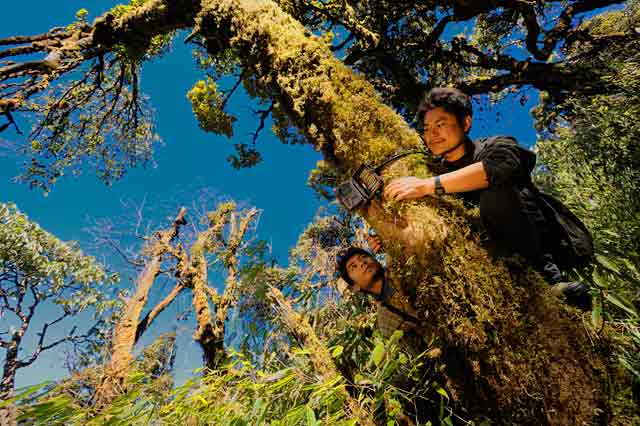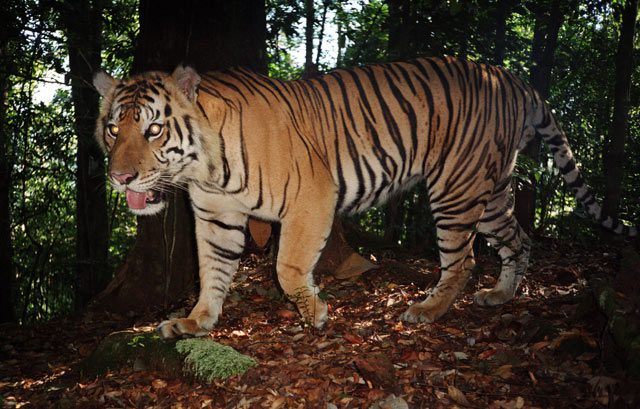The first time I camera trapped a tiger was a strange and unnerving experience. It also taught me a few things, the foremost of which was how elusive rainforest animals can be, even when they are in close proximity.

I left camp mid-afternoon with three camera traps in my backpack and followed an old logging path deeper into the forest. The darkening sky presaged a storm, so I hurried along the trail. I had been living in this forest for almost a year. Finding tiger tracks was a regular occurrence, but I had never seen a tiger firsthand and had no idea how many were in the area or whether the familiar pugmarks belonged to a male or a female.
I cut directly through the forest to meet a smaller trail along which I knew tigers regularly passed. Here I placed my first camera, noting the coordinates, date and time in my notebook. It was exactly 4pm. The low rumble of thunder made me start back to camp; a Sumatran downpour was usually a fierce affair. Scurrying back down the trail I was stopped short by a chilling sight: in one of my own boot prints was the fresh spoor of a tiger. It had followed me, leaving the trail at the exact point where I had taken the short cut.
The next morning I returned to the camera. Had this tiger really been following me? The data screen showed that something had passed through at 4:30pm. A few days later in town I checked the negatives and discovered within half an hour of setting the camera I had photographed my first tiger, a sleek female. She had followed me because she also appeared on the two other cameras I had set.
It wasn’t always this easy to see who or what was following you. As recently as two decades ago, tropical field biologists trying to determine which species of mammals occurred in a given area of forest had a difficult job. Larger animals – such as elephants, tapirs, wild cattle and tigers – leave clear footprints, making them relatively easy to identify. Smaller species, such as civets, cats and various small carnivores are much harder to find and identify correctly from secondary signs.
Even with easily identified species, it remained hard to assess how common they were. With elephants, a system of dung analysis could be employed: using a special equation, herd size could be estimated from the amount and age of dung collected. Not a pleasant task, nor necessarily a very accurate one. In short it was almost impossible to survey a forested area and come up with either a complete species list or have any idea of population sizes. Camera trapping, I quickly learned, offered a method to remotely monitor the forest and gather data on species and their abundance.

Camera trapping works by placing a camera with a remote trigger along an animal trail and waiting for the animal to pass and set off the trigger, photographing itself. Using remote cameras to photograph elusive wildlife is not a new idea – the concept has been around for over a century. The first examples used trip wires, plate cameras and flash powder, which were very impractical and scared the wildlife for miles around.
The BBC natural history unit, using sensors taken from burglar alarms, put together the first camera traps I used. They required heavy batteries and were not very sensitive. Then in the early 1990s an off-the-shelf compact camera trap became available in America. These were not originally designed for scientists, but rather for hunters trying to discover where deer with trophy-sized antlers were moving. It didn’t take long for field researchers to catch on to the potential of the technology, and soon the TrailMaster camera trap, with its infrared beam and compact film camera, was a required tool for biologists working on elusive animals.
The benefits soon became clear. Using camera traps, tiger scientists in India were able to come up with an accurate number of tigers in their research sites because individual tigers could be identified by their unique stripe patterns. Previously, pugmarks had been used to estimate population size, and these figures were found to be wildly inaccurate. Tigers in some Indian national parks were actually much more rare than had been supposed. Some species, in contrast, were found to be more common than first suspected. Owston’s civet, a species endemic to Vietnam, was believed to be extremely scarce and localised. Camera trapping showed it was neither. Other species were photographed in the wild for the first time: the Saola, a rare forest antelope recently discovered in Vietnam; the large-antlered muntjac in Laos; the new subspecies of Javan rhinoceros in Vietnam; and even the Sumatran ground cuckoo – a bird that had never been seen alive before.

As the technology has evolved, no biodiversity survey is complete without its camera trapping component. Weather-proof and able to take thousands of images, cameras can now be left in the forest for months at a time. Some units feature a video function, which allow studies of animal behaviour to be made remotely. In the most sophisticated instances, cameras can send images directly to a computer at base camp, eliminating any need to repeatedly disturb the study area.
Camera traps have been crucial in giving us a greater understanding of both species compositions and population dynamics in difficult landscapes like tropical rainforest. While showing us what is in the forest, camera traps are also telling us what is being lost. Scientists are now beginning to document the disappearance of species – tigers in Cambodia being an example. In recent years, despite concerted efforts targeted at tigers, the many camera traps set in the forests of northeast Cambodia have failed to capture any images of tigers. The most recent photograph of a tiger in Cambodia was taken in 2007, and it may well end up being the last.
Camera traps are still turning up exciting new information. Recently, hog deer, hairy-nosed otter and giant ibis were caught on camera traps in Cambodia’s Koh Kong province, somewhere they were not thought to occur. When a new species of primate, the Myanmar snub-nosed monkey, was recently discovered in northern Myanmar, the researchers turned to camera traps to get the first pictures.
It is an exciting pursuit: we never know what we are going to get. What else is out there? Who knows? Where camera traps are concerned, there are still plenty of surprises to come.
